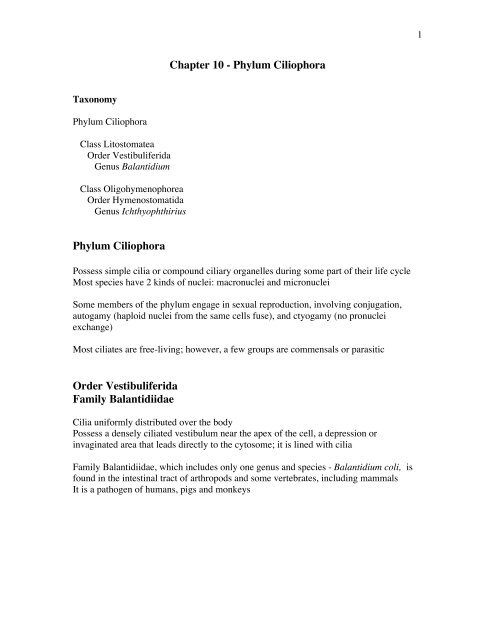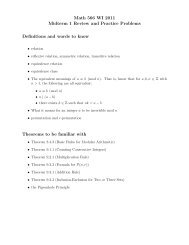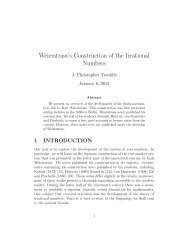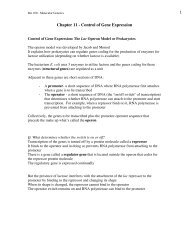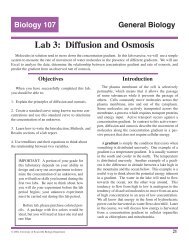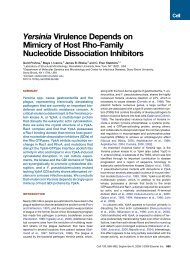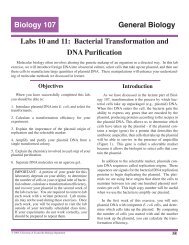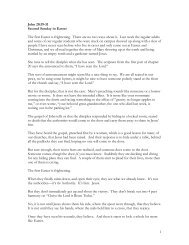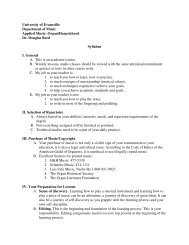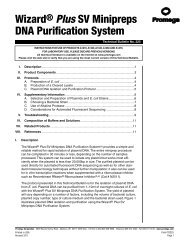Chapter 10 - Phylum Ciliophora Phylum Ciliophora Order ...
Chapter 10 - Phylum Ciliophora Phylum Ciliophora Order ...
Chapter 10 - Phylum Ciliophora Phylum Ciliophora Order ...
- No tags were found...
You also want an ePaper? Increase the reach of your titles
YUMPU automatically turns print PDFs into web optimized ePapers that Google loves.
1<strong>Chapter</strong> <strong>10</strong> - <strong>Phylum</strong> <strong>Ciliophora</strong>Taxonomy<strong>Phylum</strong> <strong>Ciliophora</strong>Class Litostomatea<strong>Order</strong> VestibuliferidaGenus BalantidiumClass Oligohymenophorea<strong>Order</strong> HymenostomatidaGenus Ichthyophthirius<strong>Phylum</strong> <strong>Ciliophora</strong>Possess simple cilia or compound ciliary organelles during some part of their life cycleMost species have 2 kinds of nuclei: macronuclei and micronucleiSome members of the phylum engage in sexual reproduction, involving conjugation,autogamy (haploid nuclei from the same cells fuse), and ctyogamy (no pronucleiexchange)Most ciliates are free-living; however, a few groups are commensals or parasitic<strong>Order</strong> VestibuliferidaFamily BalantidiidaeCilia uniformly distributed over the bodyPossess a densely ciliated vestibulum near the apex of the cell, a depression orinvaginated area that leads directly to the cytosome; it is lined with ciliaFamily Balantidiidae, which includes only one genus and species - Balantidium coli, isfound in the intestinal tract of arthropods and some vertebrates, including mammalsIt is a pathogen of humans, pigs and monkeys
2Balantidium coliMorphologyCoarse cilia line the peristomal areaMacronucleus is typically elongate and kidney-shaped, while the micronucleus issphericalThere are at least 2 prominent contractile vacuoles: one in the middle of the cell and theother near the posterior endFood vacuoles in the cytoplasm contain debris, bacteria, RBCs, and fragments of hostepitheliumLife CycleThe trophozoite inhabits the cecum and colon of humans and is the largest knownprotozoan parasite of humansTransmission from one host to another is accomplished via the cystEncystation usually occurs in the large intestine but may also occur outside the body ofthe hostCysts are common in the feces of the infected hostInfection occurs when contaminated food or water is ingestedExcystation occurs in the small intestineEpidemologyBalantidiosis is most often found in tropical regions throughout the worldHowever, it is not a common human disease; the infection rate is less than 1%Symptomatology and DiagnosisThe trophozoite resides in the cecal area and throughout the large intestineIt thrives in an environment rich in starch, such as the small intestineHowever, in such an environment, the trophozoite does not invade the intestinal mucosaIt is believed that the trophozoite secretes proteolytic enzymes that act upon the mucosalepithelium, facilitating tissue invasionResults from infection range from asymptomatic to severeParasitic invasion of the mucosal lining is followed by hemorrhage and ulceration - thename balantidine dysentery is often given to this conditionDiagnosis involves an examination of a stool sample looking for trophozoites and cysts
3<strong>Order</strong> HymenostamatidaFamily IchthyophthiriidaeAmong members of this group the buccal cavity has a well-defined oral ciliary apparatusMembers of this group are heavily ciliated and the cilia is uniformThe family has one genus that contains two species; we will discuss one of them,Ichthyophthirius multifiliis)I. multifiliis is a relatively common parasite of FW aquarium fish and fish farmsIchthyophthirius multifiliisMorphologyLarge horseshoe shaped macronucleus that encircles a smaller micronucleusMay have several contractile vacuolesLife CycleThis protozoan attacks the epidermis, cornea and gill filaments of FW fishesThe fish may die from the attack, especially when the gill filaments are attackedThe mature trophozoites form pustules in the skin of their hostsWhen the pustules rupture, they are released and usually settle on vegetation or thebottom sedimentsIt then forms a gelatinous cyst and undergoes asexual reproduction producing up to <strong>10</strong>00infective cellsThe daughter trophozoites (tomites) represent the infective stage of the life cycleIt uses a long filament that emerges from a conical depression in the pellicle to burrowinto the host’s skinAt this time it becomes a trophozoite and begins to ingest host tissue; pustules form tocomplete the life cycleTreatment of aquarium fish can involve dilute concentrations of formaldehyde ormethylene blue


